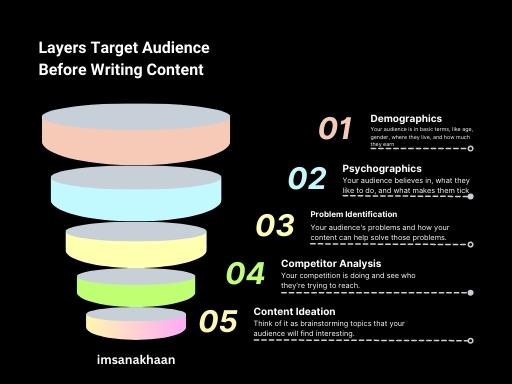Your “target audience” is the people you aim to reach with your content. It’s like speaking directly to those most interested in what you have to say or offer. This group shares common characteristics, interests, and needs, making them the prime focus of your communication.
It enables you to communicate more effectively. When you know who you’re addressing, you can tailor your message to resonate with them. This relevance makes your content more engaging and meaningful to the intended audience. Ultimately, identifying your target audience helps boost the success of your content, product, or message by ensuring it reaches and appeals to the right people, resulting in better outcomes and engagement.
While searching for your audience, the most important aspect is the difference between a blog post and an article. You should focus on the tone of voice, audience, pain point, and your content’s writing style according to the platform’s requirements.
How to Identify Your Target Audience Before Writing Content?

Here’s a simplified explanation for each step in identifying your target audience before writing content:
- Market Research: Look at what’s popular in your field and see what your competitors are up to. It’s like checking out the competition to see what’s selling well.
- Demographics: Define who your audience is in basic terms, like age, gender, where they live, and how much they earn. Imagine you’re making a profile of your ideal customer.
- Psychographics: Think about what your audience believes in, what they like to do, and what makes them tick. It’s like understanding their hobbies and what motivates them.
- Problem Identification: Figure out your audience’s problems and how your content can help solve those problems. You’re like a helpful guide here.
- Goals and Aspirations: Understand what your audience wants to achieve. It’s like knowing what’s on their wishlist.
- Behavior and Preferences: Learn where your audience hangs out online, how they use the internet, and what content they enjoy. Think of it as knowing their favorite online spots.
- Keyword Research: Use tools to find out what words and phrases your audience uses when they’re looking for information. It’s like discovering the secret codes they type into search engines.
- Create Buyer Personas: Make up imaginary people who represent your ideal customers. Give them names, backgrounds, and quirks to understand their needs better. It’s like creating characters in a story.
- Competitor Analysis: Study what your competition is doing and see who they’re trying to reach. Look for gaps where you can offer something different and special.
- Feedback and Surveys: Ask your current customers what they like and need. It’s like having a conversation with them to get their thoughts.
- Content Ideation: Come up with ideas for content that tackles the problems and goals of your audience. Think of it as brainstorming topics that your audience will find interesting.
- Content Personalization: Customize your content to speak directly to certain individuals in your audience. Use their words, talk about their problems, and offer solutions that matter to them. It’s like having a one-on-one conversation.
How To Tailor Content to Your Target Audience?
Language and Tone
- Choose Words Wisely: Select vocabulary that resonates with your audience. If you’re addressing professionals, use industry-specific terms. For a casual audience, use conversational language.
- Adapt Tone: Adjust the tone of your content to match your audience’s preferences. If your audience is formal, maintain a professional tone. If they prefer a friendly, casual tone, keep it relaxed.
Content Format
- Visual Appeal: Consider the visual preferences of your audience. Use more visuals like images and infographics for a visually-oriented audience and detailed text for those who prefer in-depth content.
- Mobile Optimization: Make sure your content is mobile-friendly for audiences who predominantly use smartphones for browsing.
Content Topics
- Relevant Themes: Focus on topics that align with your audience’s interests and concerns. For example, discuss the latest tech trends if you’re writing for a tech-savvy audience.
- Trend Analysis: Keep your content up-to-date by addressing current trends and issues in your industry.
Incorporating Pain Points
- Problem-Solving: Address the specific pain points and challenges your audience faces. Offer solutions and practical advice that can help them overcome these issues.
- Empathy: Show empathy in your content by acknowledging your audience’s struggles. This helps in building a connection with them.
Benefits and Solutions
- Highlight Benefits: Communicate the benefits your audience will gain from your content, product, or service. Whether it’s time savings, cost-effectiveness, or enhanced well-being, emphasize these advantages.
- Solution-Centric: Your content should revolve around providing solutions. Demonstrate how your offering can address the needs of your audience effectively.
Emotional Appeal
- Connect Emotionally: Craft content that triggers emotional responses. Use storytelling and visuals to create an emotional bond with your audience, whether it’s joy, fear, excitement, or nostalgia.
- Relatability: Share relatable stories and experiences your audience can connect with, making your content more engaging and memorable.
We Have Concluded
The key to effective communication is to craft content that caters to your target audience. By adapting language, tone, format, and content topics, addressing pain points, emphasizing benefits, and establishing emotional connections, you engage your audience and build lasting relationships that lead to success and satisfaction.



